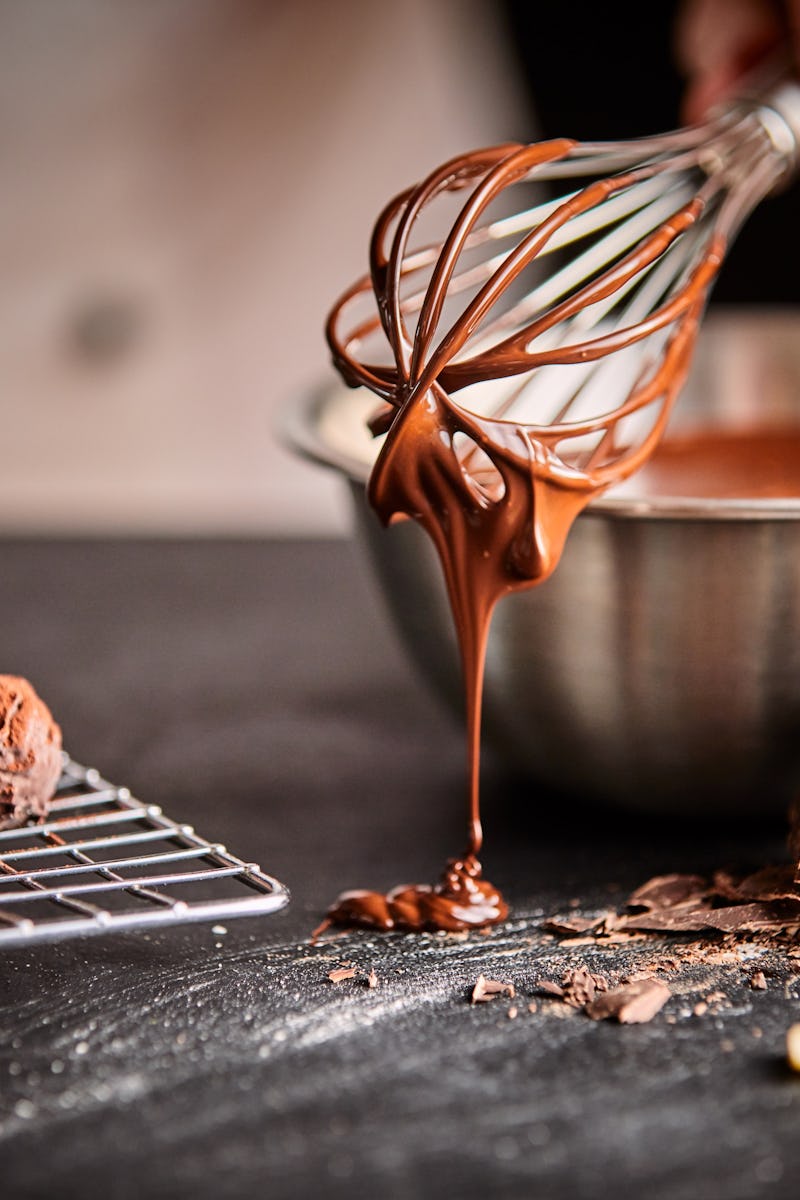
Shutterstock
“Properly tempered chocolate always tastes better!”
Chemists use a novel hack to invent better chocolate
The delicious chemistry of chocolate is often exact and tedious, but scientists have just created a shortcut to achieve beautiful chocolate in record time.
by Sarah WellsIt’s a velvety richness that melts in your mouth the moment you take a bite. Sweet and creamy, chocolate is a treat loved the world over, whether you’re enjoying squares of a chocolate bar, a fudgy chocolate cake, or sipping on a thick hot chocolate.
But while this childhood staple may seem like a simple pleasure, the science behind it is actually incredibly complex. Especially when it comes to a culinary and chemical process called “tempering.”
Alejandro Marangoni is a food scientist and researcher at the University of Guelph. He tells Inverse that your chocolate bars would have no gloss and no snap and taste worse without tempering.
“Without proper tempering, chocolate can either melt at too low or too high temperatures and have the wrong snap and gloss,” Marangoni says. “Properly tempered chocolate always tastes better!”
Tempering is traditionally a tedious — and often, inconsistent — process for chocolatiers. But in a paper published Tuesday in the journal Nature Communications, Marangoni and colleagues found a way to achieve perfectly tempered chocolate every time by adding one simple ingredient — and it may just make your favorite treat more sustainable.
Meticulously controlling the temperature of melted chocolate while tempering it can be the difference between beautiful, glossy chocolate or chocolate that’s dull and limp.
What’s new — When it comes to chocolate flavor, it’s usually the cocoa solids — the rich but bitter product of dried cocoa beans — that get all the fanfare. But just as important as these cocoa solids is the fat the binds them altogether: cocoa butter. It’s the most important component in perfecting the texture of a piece of chocolate, Marangoni says.
“Cocoa butter crystallization is a very complex process with six possible different crystal forms,” Marangoni says. But he says only one provides the desired melting properties and hardness for tempering.
This crystalline state is usually achieved through a meticulous process of heating and cooling the liquid chocolate, but the tempering process is very energy-intensive and also tricky to pull off perfectly 100 percent of the time.
Hidden within unassuming cacao pods are the two main ingredients for rich, delicious chocolate: cocoa solids and cocoa butter.
What they did — Instead of perfecting the existing technique, Marangoni and colleagues chose to look to the cocoa butter itself for inspiration.
They started by isolating minor components before adding them to refined cocoa butter, examining the results to find the perfect combination. “We found one family had a huge effect on the crystallization behavior and thus tempering behavior of the cocoa butter and chocolate,” Marangoni says.
For all the complex chemistry hidden within our chocolate, Marangoni says the technique to transform the tempering process was actually quite simple.
“We simply added the solid powder to a molten batch of chocolate at 50 degrees Celsius,” explains Marangoni. “After simply stirring, we crystallized it at 22 degrees Celsius and voila … properly tempered chocolate.”
Because the powdered phospholipid (a kind of molecule found in cocoa butter that has a hydrophilic, or water-loving, “head” and two hydrophobic, or water-hating, “tails”) the team added to the chocolate is already present in cocoa butter, Marangoni says this addition had no impact on the taste. And in fact, it may even improve the experience by affecting the overall texture of the treat.
“All flavor development comes from fermentation, roasting, conching, and the other ingredients,” says Marangoni. “[But] of course, melting affects flavor perception.”
Why it matters — More than simply saving chocolate producers time and effort, Marangoni says this new technique could be a big energy saver too.
“Simplifying the process, we can reduce energy requirements for industrial tempering of chocolate and improve on carbon footprint and thus sustainability.”
Unwrapping a perfectly tempered chocolate bar may not get you a trip to the Wonka factory, but that taste will be worth it nonetheless.
What’s next — Will this invention will keep home cooks from toiling over double boilers of meticulously tempered chocolate? The answer is maybe. But where the future of this technique will really shine — pun intended — is in the production of chocolate bars.
“This technology is really geared towards making eating chocolate,” Marangoni says. “Companies will benefit from this the most, but this also opens us possibilities for smaller operations and the home chocolatier to product well-tempered chocolate without the need for a tempering unit or complex tempering regimes.”
Abstract: Chocolate manufacture includes a complex tempering procedure to direct the crystallization of cocoa butter towards the formation of fat crystal networks with specific polymorphism, nano- and microstructure, melting behavior, surface gloss and mechanical properties. Here we investigate the effects of adding various minor non-triglyceride lipidic components to refined cocoa butter and chocolate on their physical properties. We discover that addition of saturated phosphatidylcholine and phosphatidylethanolamine to neutralized and bleached cocoa butter or molten and recrystallized commercial chocolate at 0.1% (w/w) levels, followed by rapid cooling to 20 °C in the absence of shear, accelerates crystallization, stabilizes the desirable Form V polymorph and induces the formation of chocolate with an optimal microstructure, surface gloss and mechanical strength. Final chocolate structure and properties are comparable to those of a commercial tempered chocolate. Minor lipidic component addition represents an effective way to engineer chocolate material properties at different length scales, thus simplifying the entire tempering process.
This article was originally published on